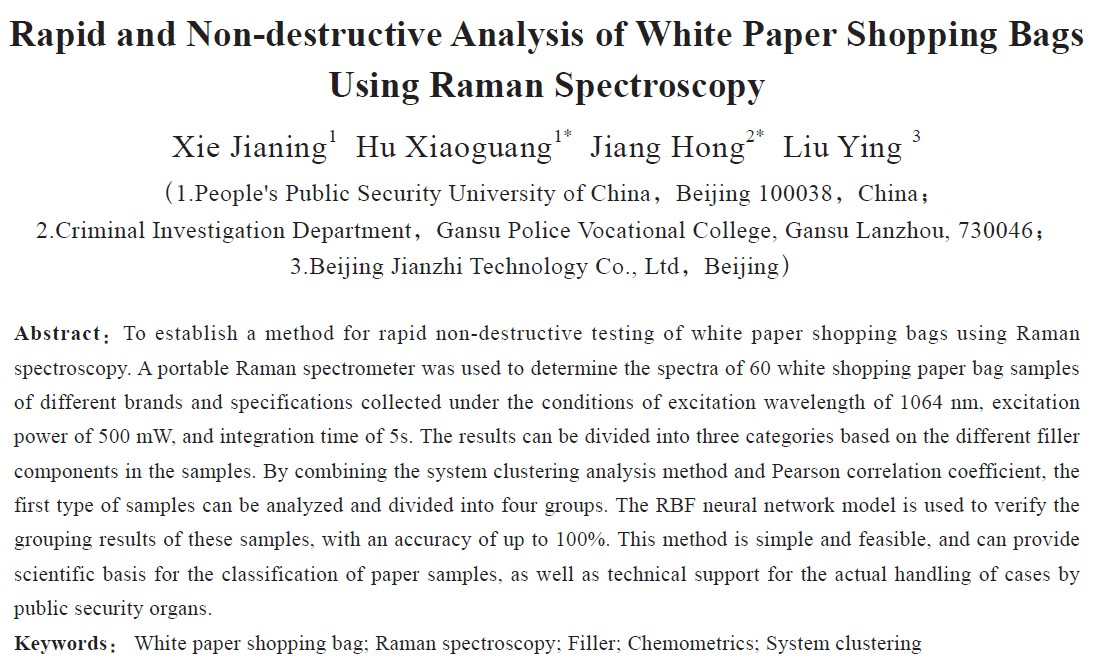1 Literature Source
2 Content Summary
With the increasing awareness of environmental protection, white paper shopping bags have gained widespread use in daily life due to their reusable and eco-friendly characteristics. These shopping bags exhibit high stiffness, burst strength, and smoothness, which have also made them a tool for criminal activities. However, the market offers a wide range of brands and specifications of white paper shopping bags, with varying material compositions and quality. Therefore, developing a rapid and non-destructive inspection method to distinguish white paper shopping bags with different material compositions and qualities is crucial for providing technical support to public security authorities in related cases.
In 2023, a team led by Xiaoguang Hu from the People’s Public Security University of China and a team led by Hong Jiang from Gansu Police Vocational College jointly developed a rapid and non-destructive method using Raman spectroscopy to identify white paper shopping bags. The research team utilized the JINSP RS2100 portable Raman spectrometer to acquire Raman spectra of 60 white paper shopping bag samples from different brands and specifications under the conditions of an excitation wavelength of 1064 nm, excitation power of 500 mW, and integration time of 5 s. The samples were classified into three primary categories based on the analysis of their filler components. For the first category, further analysis was performed using systematic clustering analysis methods and Pearson correlation coefficients, dividing them into four subgroups. Finally, the validity of the grouping results was confirmed using a Radial Basis Function (RBF) neural network model.
Experimental results indicate that the established rapid and non-destructive Raman spectroscopy analysis method can effectively classify and identify white paper shopping bags. Using systematic cluster analysis and Pearson correlation coefficients, the first group was successfully divided into four subgroups, and the RBF neural network model achieved a validation accuracy of 100%. This method is not only simple and feasible but also provides a scientific basis for the classification of paper samples, offering robust technical support for law enforcement agencies in related investigations. Additionally, this method can be applied to the classification and identification of other paper materials, showcasing its wide applicability and promising prospects.
It is worth mentioning that the JINSP® RS2100 portable Raman spectrometer played a crucial role in this research. This portable Raman spectrometer is equipped with the JINSP® ST50S transmission imaging spectrometer, which utilizes VPH volume phase holographic gratings with a diffraction efficiency close to 90%, 2-4 times higher than reflective blazed gratings. Combined with an optical path design with excellent imaging performance, it achieves a limit resolution twice that of traditional spectrometers, delivering exceptional spectral detection results. Furthermore, it is equipped with a refrigerated high-sensitivity InGaAs camera that exhibits excellent sensitivity and signal-to-noise ratio in the near-infrared band.
The comprehensive optical performance metrics of the ST50S can replace and surpass traditional research-grade InGaAs spectrometers, making it an excellent configuration for 1064 nm Raman spectroscopy systems requiring high sensitivity. Additionally, it boasts high stability and a compact size, making it highly suitable for integration into industrial equipment.
In summary, Raman spectroscopy not only provides technical support for combating criminal activities in practical police investigations, but also aids in narrowing the scope of investigations, demonstrating tremendous potential and value in the field of forensic science. By integrating the ST50S transmission imaging spectrometer from JINSP, rapid and high-quality near-infrared Raman spectroscopy detection can be achieved, offering robust technical support for the application of Raman spectroscopy in forensic science. For more details, please visit: Best ST50S Transmission Imaging Spectrometer manufacturers and suppliers | JINSP (jinsptech.com)
3 Instrument recommendation |ST50S transmission spectrometer

Product Specifications
|
Specification |
Parameters |
|
|
Detector
|
Camera type |
Back-illuminated deep depletion (NIR optimized) |
|
Effective pixel |
2000*256 |
|
|
Pixel size |
15μm*15μm |
|
|
Cooling temperature |
-70℃ |
|
|
Optical Parameters
|
Wavelength range |
785nm~988nm Corresponds to 0~2,600cm-1 |
|
Optical resolution |
0.35nm, correspond to 5cm-1(50μm silt) 0.25nm, correspond to 3cm-1(25μm silt) |
|
|
Grating type |
VPH grating |
|
|
Diffraction efficiency |
>85% |
|
|
Input interface |
SMA905 or Φ10mm multicore fiber |
|
|
Free space access |
NA0.25 |
|
|
Electrical Parameters
|
Integration time |
1ms-3,600s |
|
Output interface |
USB Type-B |
|
|
ADC bit depth |
16bit |
|
|
Supply |
DC12V (± 0.5V) |
|
|
Working current |
3A |
|
|
Temperature(operation) |
-20℃~60℃ |
|
|
Temperature(storage) |
-30℃~70℃ |
|
|
Humidity |
< 90%RH (no condensation) |
|
|
Physical Parameters
|
Dimensions |
364mm*200mm*124mm |
|
Weight |
<5kg (including camera) |
|
Post time: Jun-14-2024


